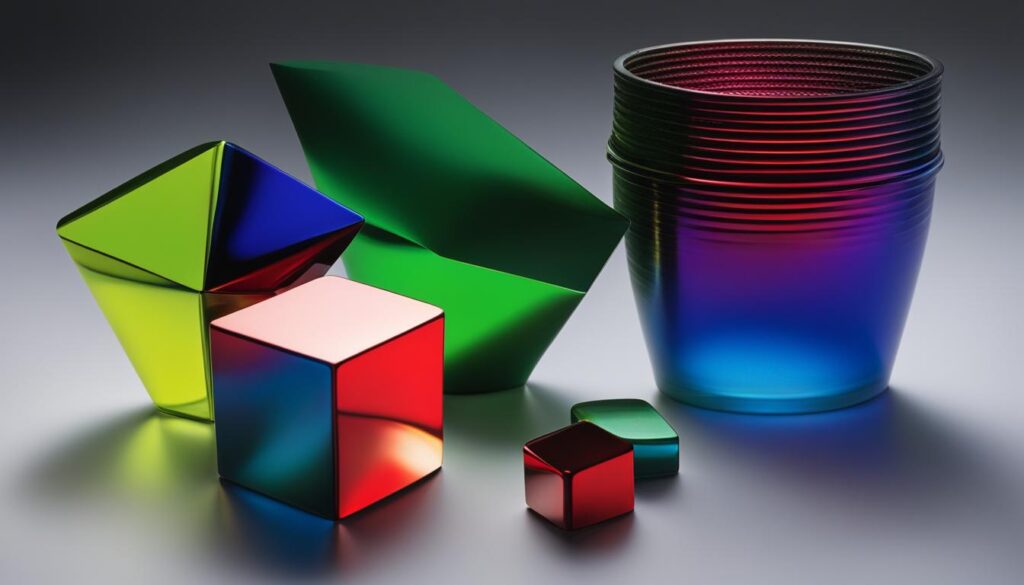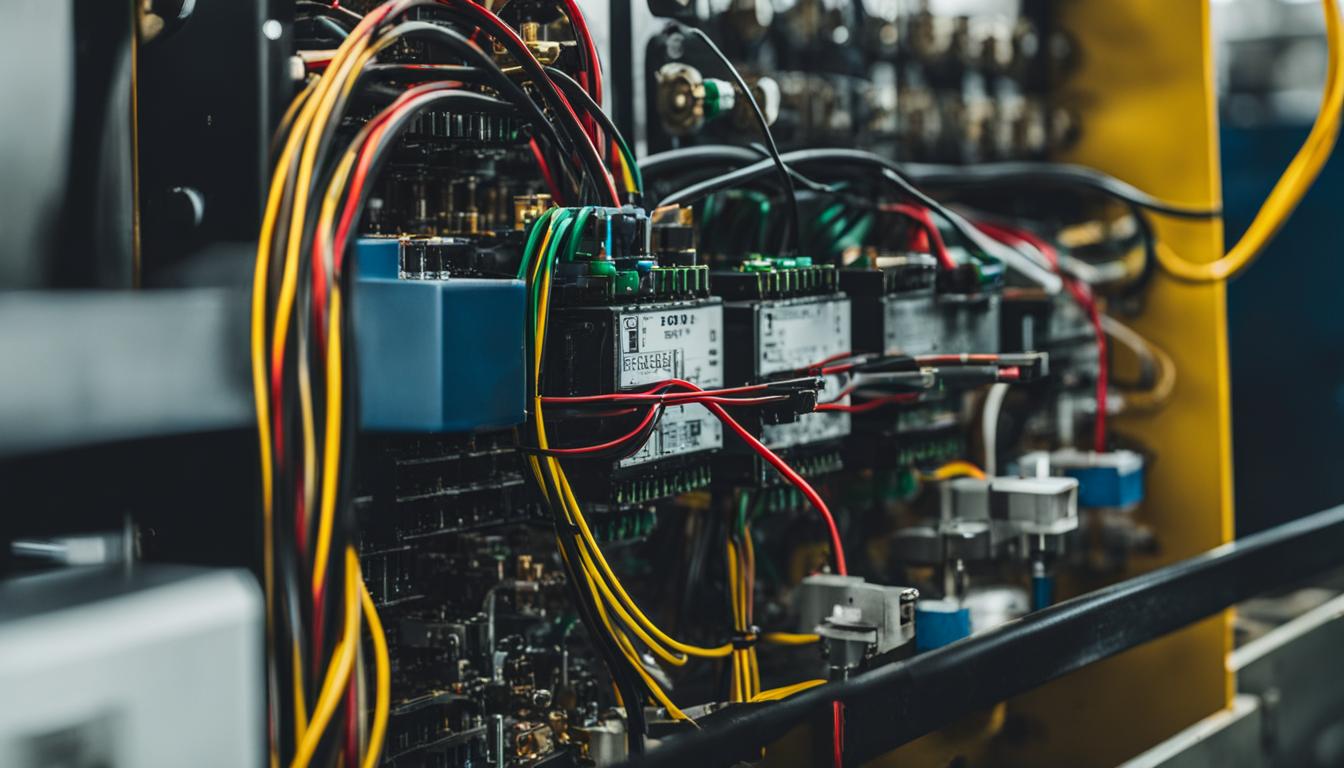Welcome to our article on anodizing for increased electrical conductivity. In this guide, we will explore the process of anodizing aluminum and how it improves the properties of this versatile material. While anodizing offers several benefits like wear resistance, corrosion resistance, and improved adhesion, it also has limitations, particularly when it comes to electrical conductivity. By understanding the different types of anodizing and its specifications, as well as considering alternative finishing treatments, you can make informed decisions about whether anodizing is the right choice for your aluminum products.
Key Takeaways:
- Anodizing enhances wear resistance, corrosion resistance, and adhesion properties of aluminum.
- Anodizing significantly reduces the electrical conductivity of aluminum.
- Type I, II, and III anodizing vary in the thickness of the oxide layer.
- Anodizing may not be suitable for applications that require high electrical conductivity.
- Consider alternative finishing treatments like powder coating or PVDF coating for specific requirements.
What is Anodizing and How Does it Work?
Anodizing is a process that naturally occurs on aluminum when it comes into contact with certain elements. This process involves immersing the aluminum part in an electrolytic bath and applying a high-amperage, low-voltage electrical current. The application of electrical current induces an oxidation chemical reaction, which leads to the thickening of the naturally-occurring oxide layer on the surface of aluminum. This thickened oxide layer provides enhanced properties and benefits.
The anodizing process does not require the application of any external product or material to the surface of aluminum. Instead, it relies on the chemical reaction between the aluminum and the electrolytic bath, resulting in the formation of a durable oxide layer. This oxide layer improves the wear resistance and corrosion resistance of the aluminum, making it more suitable for various applications.
The anodizing process can be visualized as follows:
Aluminum Part + Electrolytic Bath + Electrical Current = Thicker Oxide Layer
By immersing the aluminum part in the electrolytic bath and applying the electrical current, the oxidation chemical reaction occurs, leading to the thickening of the oxide layer. This process alters the surface properties of the aluminum, providing it with increased durability and resistance to wear and corrosion.
Anodizing is a chemical transformation of the aluminum surface, resulting in the formation of a thick oxide layer. The thickness of this oxide layer can vary depending on the specific anodizing process used and the desired outcome.
Anodizing Process Steps:
| Step | Description |
|---|---|
| 1 | Prepare the aluminum part by cleaning and degreasing it. |
| 2 | Immerse the part in an electrolytic bath. |
| 3 | Apply a high-amperage, low-voltage electrical current to the bath. |
| 4 | Monitor the process until the desired oxide layer thickness is achieved. |
| 5 | Rinse and dry the anodized aluminum part. |
Benefits of Anodizing for Enhanced Electrical Conductivity
Anodizing aluminum offers several benefits for enhanced electrical conductivity. During the anodizing process, a thick oxide layer is formed on the surface of the aluminum, which provides improved wear resistance and enhances the durability of the material. This is particularly advantageous in applications that involve frequent contact or exposure to abrasive conditions, as the anodized surface is better equipped to withstand wear and tear.
Furthermore, anodizing enhances the corrosion resistance of aluminum. The oxide layer acts as a protective barrier, shielding the underlying aluminum from environmental factors that can cause corrosion. As a result, anodized aluminum is more resistant to rust, tarnish, and other forms of degradation, making it suitable for applications in various industries, including construction, automotive, and marine.
In addition to improved wear and corrosion resistance, anodizing creates a porous surface on the aluminum. This porous structure allows for the application of dyes, enabling the customization of the aluminum with vibrant and long-lasting colors. Whether it’s for architectural purposes or aesthetic considerations, the dye application on anodized aluminum provides an elegant finish that can withstand the test of time.
Another benefit of anodizing is its ability to enhance the adhesion of glue or primer to the aluminum surface. The porous nature of the anodized layer provides a textured surface that improves the bonding of adhesives, enhancing the overall strength and integrity of assembled parts. This makes anodized aluminum an ideal choice for applications that require strong bonding, such as in the aerospace and electronics industries.
Moreover, the increased surface area resulting from anodizing improves the heat dissipation capabilities of aluminum. This is particularly relevant in applications that involve heat transfer or require effective thermal control, such as heat sinks or electronic enclosures. The enhanced thermal properties of anodized aluminum contribute to improved performance and reliability in these applications.
Overall, anodizing offers a range of benefits for enhanced electrical conductivity. From improved wear and corrosion resistance to the ability to apply dyes and enhance adhesive bonding, anodized aluminum provides a versatile and reliable solution for various industries.

Limitations of Anodizing for Electrical Conductivity
While anodizing offers many benefits, it comes with limitations, particularly concerning electrical conductivity. Anodizing involves the formation of an oxide layer on the surface of aluminum, which contributes to improved wear resistance and corrosion resistance. However, this oxide layer also reduces the electrical conductivity of aluminum, making it less suitable for applications where high conductivity is required.
Anodized aluminum has properties resembling ceramics, which are known electrical insulators. The oxide layer acts as a barrier to the flow of electric current, resulting in lower electrical conductivity compared to untreated aluminum. Although anodized aluminum still exhibits limited conductivity through contact due to the thinness of the oxide layer, it is significantly inferior to the conductivity of untreated aluminum.
If electrical conductivity is a crucial consideration in the design of aluminum products, anodizing may not be the ideal finishing treatment. Alternative options should be explored to ensure the desired level of electrical conductivity is achieved.
“The oxide layer formed during anodizing acts as an electrical insulator, reducing the conductivity of aluminum. It’s essential to consider the specific electrical requirements when deciding on the finishing treatment for aluminum products.” – Aluminum Solutions Inc.
Comparison of Electrical Conductivity: Anodized Aluminum vs. Untreated Aluminum
| Properties | Anodized Aluminum | Untreated Aluminum |
|---|---|---|
| Electrical Conductivity | Lower Conductivity | Higher Conductivity |
| Conductivity Through Contact | Limited | Unimpeded |
Table: A comparison of electrical conductivity between anodized aluminum and untreated aluminum.
Types of Anodizing and Specifications
Anodizing aluminum offers various types of specifications to achieve desired outcomes. Three commonly used types of anodizing are Type I, Type II, and Type III, each with specific characteristics and applications. These types are specified based on the desired thickness of the resulting oxide layer and the specific requirements of the project.
Type I Anodizing: Type I anodizing, also known as chromic acid anodizing, is performed by immersing the aluminum part in a bath of chromic acid. This type of anodizing results in a thin oxide layer, typically ranging from 0.5 to 3 micrometers in thickness. Type I anodizing is commonly used when corrosion resistance is a primary concern and electrical conductivity needs to be retained.
Type II Anodizing: Type II anodizing is performed using a sulfuric acid bath. It results in a thicker oxide layer compared to Type I anodizing, typically ranging from 1.8 to 25 micrometers in thickness. This type of anodizing provides improved wear resistance, corrosion resistance, and can be dyed to achieve a wide range of colors. It is widely used in various industries where enhanced durability and aesthetic appeal are desired.
Type III Anodizing (Hard Anodizing): Type III anodizing, also known as hard anodizing, is similar to Type II anodizing but results in a much thicker oxide layer. The oxide layer formed during Type III anodizing is typically thicker than 25 micrometers, making it highly wear-resistant and providing exceptional hardness. This type of anodizing is commonly used in applications that require maximum durability and improved abrasion resistance.

Table: Comparison of Types of Anodizing and Their Specifications
| Type | Oxide Layer Thickness | Primary Characteristics | Applications |
|---|---|---|---|
| Type I (Chromic Acid Anodizing) | 0.5-3 micrometers | Corrosion resistance, electrical conductivity | Electrical components, aerospace parts |
| Type II (Sulfuric Acid Anodizing) | 1.8-25 micrometers | Wear resistance, corrosion resistance, dyeability | Architectural components, consumer goods |
| Type III (Hard Anodizing) | Thicker than 25 micrometers | Exceptional hardness, abrasion resistance | Firearms, military equipment |
MIL-A-8625: MIL-A-8625 is a military specification that establishes the requirements for anodizing services used in various defense applications. It outlines the specific procedures, quality standards, and testing methods to ensure the compliance and suitability of anodized coatings for military purposes. Adhering to MIL-A-8625 ensures the consistent quality and performance of anodized parts in military and defense-related applications.
Considerations for Anodizing Aluminum Products
When deciding whether to anodize aluminum products, it is essential to consider the intended applications and specific requirements. Anodizing provides corrosion resistance and a metallic appearance, making it suitable for products where these properties are desired. However, anodizing may not be suitable if electrical conductivity is crucial or if further forming processes need to be performed on the piece, as this can cause the oxide layer to crack. Anodizing also slightly increases the dimensions of the piece, which may not be suitable for products with tight size tolerances. Alternatives to anodizing include powder coating for a bright colored finish or PVDF coating for extended durability and protection against UV fading.
Before proceeding with anodizing, it is important to consider the following factors:
Corrosion Resistance
Anodizing significantly improves the corrosion resistance of aluminum products. The formation of a thick oxide layer creates a protective barrier that prevents the underlying metal from reacting with the environment. This makes anodized aluminum highly resistant to rust and other forms of corrosion.
Metallic Appearance
Anodizing gives aluminum products a sleek, metallic appearance that is aesthetically pleasing. The anodized surface enhances the natural luster of aluminum, making it an attractive choice for various applications in industries such as architecture, automotive, and consumer electronics.
Thermal-Control/Optical Properties
Depending on the specific requirements, anodized aluminum can be engineered to possess thermal-control and optical properties. For example, anodized aluminum can be used in heat sinks to dissipate heat effectively or in solar panels to optimize light absorption.
Dimensional Changes
It is essential to account for dimensional changes when anodizing aluminum products. The thickness of the oxide layer adds to the dimensions of the original piece. While the increase is minimal, it can affect products with tight tolerances or precise fitments.
Alternatives to Anodizing
If anodizing is not suitable for a particular application, there are alternative finishing treatments available. Powder coating provides a durable and vibrant colored finish, offering a wide range of customization options. PVDF coating, on the other hand, provides extended durability and protection against UV fading, making it ideal for outdoor applications.
When deciding whether to anodize aluminum products, a thorough evaluation of the specific requirements and considerations is crucial. It is essential to weigh the benefits of anodizing, such as corrosion resistance and a metallic appearance, against the limitations, such as reduced electrical conductivity and dimensional changes. Additionally, exploring alternative finishing treatments can provide tailored solutions that meet the desired specifications and requirements.
Anodizing for Electrical Conductivity in Other Industries
Anodizing is not limited to enhancing the properties of aluminum solely for wear resistance and corrosion protection. In industries where electrostatic discharge suppression is crucial, anodizing can be a valuable solution. By applying a transparent, electrically conductive metal oxide nanocomposite coating to the anodized aluminum surface, the electrical resistivity of the material is significantly reduced. This allows for effective electrostatic discharge suppression, making anodized aluminum suitable for applications in the electronics industry.
The nanocomposite coating becomes an integral part of the anodized aluminum substrate, providing a durable and cost-effective alternative to expensive electrostatic-discharge-suppressing finishes. With anodizing, industries can achieve both the desired electrical conductivity and the beneficial properties of anodized aluminum, such as enhanced wear resistance and corrosion protection.
Table: Comparison of Electrical Resistivity of Anodized Aluminum with and without Nanocomposite Coating
| Anodized Aluminum | Anodized Aluminum with Nanocomposite Coating |
|---|---|
| High electrical resistivity | Significantly reduced electrical resistivity |
| Expensive electrostatic-discharge-suppressing finishes required | Cost-effective solution for electrostatic discharge suppression |
| Limited conductivity | Enhanced electrical conductivity |
| Improved wear resistance and corrosion protection | Retains enhanced wear resistance and corrosion protection |
With anodizing and the application of the nanocomposite coating, industries can achieve the necessary electrical conductivity while benefiting from the cost-effectiveness and durability of anodized aluminum. This approach offers a practical and efficient solution for electrostatic discharge suppression in various applications, including electronics and manufacturing.
Conclusion
Anodizing provides numerous benefits for enhancing the electrical conductivity of aluminum products. It improves wear resistance, increases corrosion resistance, and creates a porous surface for dye application and improved adhesion. However, it is important to note that anodizing significantly reduces the electrical conductivity of aluminum, making it less suitable for applications that require high conductivity.
To achieve the desired outcome, it is crucial to consider the specific requirements and limitations of anodizing, as well as alternative finishing treatments. Tailored specifications, such as the type of anodizing and the thickness of the oxide layer, can be utilized to optimize the electrical conductivity while still benefiting from the other advantages of anodizing.
Overall, anodizing provides a cost-effective solution for improving the properties of aluminum components for various applications. By selecting the appropriate anodizing process and specifications, designers and manufacturers can enhance the performance and durability of their aluminum products, striking a balance between electrical conductivity and other desirable characteristics.
FAQ
What is anodizing and how does it work?
Anodizing is a process that enhances the properties of the naturally-occurring oxide layer on the surface of aluminum. It involves immersing the aluminum part in an electrolytic bath and applying a high-amperage, low-voltage electrical current to induce an oxidation chemical reaction. This reaction thickens the naturally-occurring oxide layer on the aluminum, providing enhanced properties.
What are the benefits of anodizing for enhanced electrical conductivity?
Anodizing improves wear resistance, enhances corrosion resistance, provides a porous surface for dye application, and enhances the adhesion of glue or primer.
What are the limitations of anodizing for electrical conductivity?
Anodizing significantly reduces the electrical conductivity of aluminum, although it still retains limited conductivity through contact due to the thinness of the oxide layer.
What are the different types of anodizing and specifications?
Anodizing can be specified using different types, including Type I, Type II, and Type III. It varies in the thickness of the resulting oxide layer. Type II anodizing has a layer thickness ranging from 1.8 to 25 micrometers, while Type III anodizing has oxide layers thicker than 25 micrometers. The common military specification used is MIL-A-8625.
What considerations should be made for anodizing aluminum products?
When deciding whether to anodize aluminum products, it is essential to consider the intended applications and specific requirements. Anodizing provides corrosion resistance and a metallic appearance, making it suitable for products where these properties are desired. However, anodizing may not be suitable if electrical conductivity is crucial or if further forming processes need to be performed on the piece. It also slightly increases the dimensions of the piece, which may not be suitable for products with tight size tolerances. Alternatives to anodizing include powder coating and PVDF coating.
How can anodizing be used for electrical conductivity in other industries?
Anodizing can be used to impart electrical conductivity in other industries where electrostatic discharge suppression is required. The treatment involves coating the anodized aluminum surface with a transparent, electrically conductive metal oxide nanocomposite.
What is the conclusion regarding anodizing for electrical conductivity?
Anodizing offers several benefits for enhanced electrical conductivity in aluminum products. However, it significantly reduces the electrical conductivity of aluminum, making it less suitable for applications where electrical conductivity is crucial. It is essential to consider the specific requirements and limitations of anodizing, as well as alternative finishing treatments. Tailored specifications, such as the type of anodizing and thickness of the oxide layer, can be used to achieve the desired outcome. Overall, anodizing provides a cost-effective solution for improving the properties of aluminum components for various applications.




